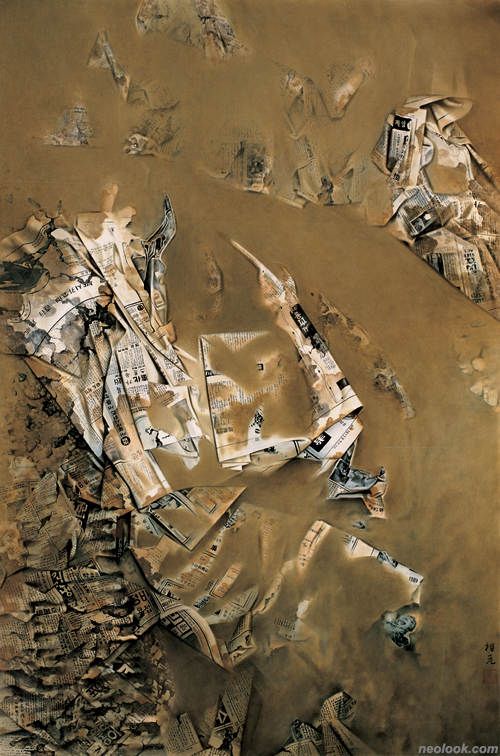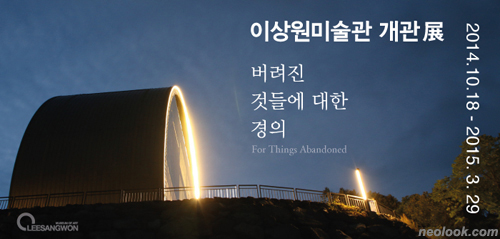- ● homepage
- ● archives
- ● restoration
- ● books
- ● big banners
- ● post board
- ■ neo's search
- ■ about us
- ■ 게재방법 안내
- 개인정보처리방침

- [email protected]
- Tel. 02_335_7922
- Fax. 02_335_7929
- 10:00am~04:30pm
- 월요일~금요일
- 3/3(월) 대체공휴일

이상원 미술관 개관전 버려진 것들에 대한 경의 For Things Abandoned
이상원展 / LEESANGWON / 李相元 / painting 2014_1018 ▶ 2015_0329 / 월요일 휴관
● 위 이미지를 클릭하면 네오룩 아카이브 Vol.20090624b | 이상원展으로 갑니다.
초대일시 / 2014_1018_토요일_04:00pm
관람료 / 성인 6,000원 / 학생(초,중,고) 4,000원
관람시간 / 10:00am~06:00pm / 매표마감_05:00pm / 월요일 휴관
이상원 미술관 LEESANGWON MUSEUM OF ART 강원도 춘천시 사북면 화악지암길 99(지암리 587번지) Tel. +82.33.255.9001 blog.naver.com/lswmuseum
이상원미술관은 이상원 화백의 40년간의 畵業의 결실인 2000여점과 한국현대회화 1000여점을 바탕으로 강원도 춘천 화악산자락에 개관합니다.『버려진 것들에 대한 경의 For Things Abandoned』展은 이상원 미술관의 개관을 알리는 개관기념전시입니다. 전시는 총 60여점의 회화작품으로 구성되었고 1977년부터 2013년까지 제작된 이상원 화백의 작품세계에 대한 이해를 돕고자 기획되었습니다.
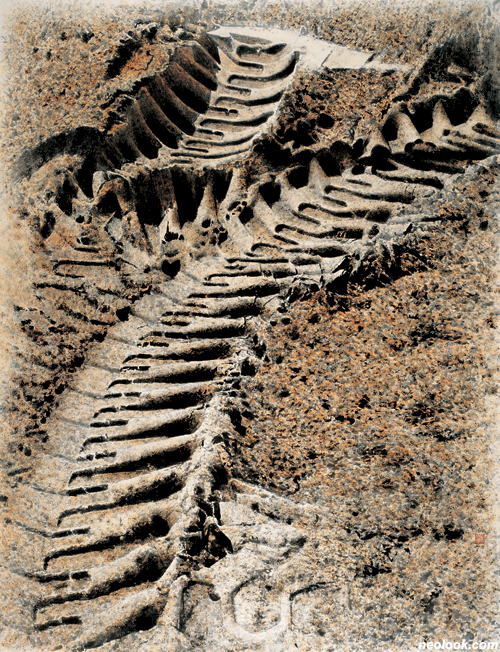
- 이상원_시간과 공간 The Time and Space_한지에 먹, 유채_167×132cm_1994
시간과 공간 ● 「시간과 공간」연작은 이상원 화백이 한국 화단에 의해 주목받는 계기가 된 작품입니다. 초기(1970년대 후반)의「시간과 공간」은 진흙바닥이나 추수를 마친 논밭위의 자동차 바퀴자국을 그린 것입니다. 이후 1990년대에는 흰 눈 위를 지나간 바퀴자국이 주 소재로 그려집니다. 진흙과 논밭 위의 바퀴자국은 문명에 의해 상처 난 대지의 느낌이 강하였다면 후기의「시간과 공간」은 추상적이며 은유적인 해석이 가능한 정제된 조형작품으로 변화하였습니다. 이상원 화백의 전 작품에 현대 문명을 암시하는 유일한 요소가 자동차바퀴 자국이라는 점은 작품에 대한 다양한 해석을 불러일으킵니다.

- 이상원_동해인 The East Sea People_한지에 먹, 유채_126×163cm_2002
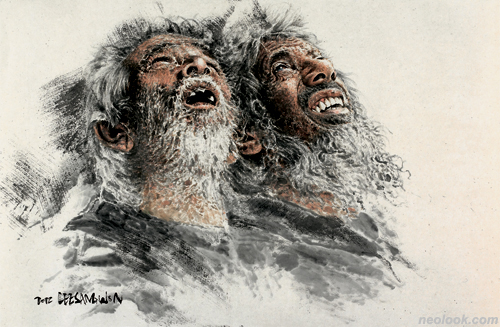
- 이상원_영원의 초상 The Portrait of Eternity_한지에 먹, 유채_83×126cm_2012
동해인 · 영원의 초상 ● 인물화는 1990년대에 제작되기 시작했습니다. 동해 바닷가 어촌의 인물들을 소재로「동해인」연작이 제작되었으며 2000년대에 들어서는 인도 바라나시에서 생활하는 사람들이 그려졌습니다. 이상원 화백이 표현하는 인간의 전형은 고통스런 삶을 암시합니다. 작품세계의 기저에 흐르는 소외된 것들에 대한 관심과 일맥상통합니다. 특히 용도 폐기되어 버려진 사물과 나란히 제시되는 인물은 전율을 느끼게 합니다. 문명의 주인으로 자처하는 인간의 지위가 역전되는 순간이기 때문입니다. 또한 작품은 소멸에 가까이 다가간 모습을 담담하게 보여줌으로써 역설적으로 생의 고귀함을 표현합니다.
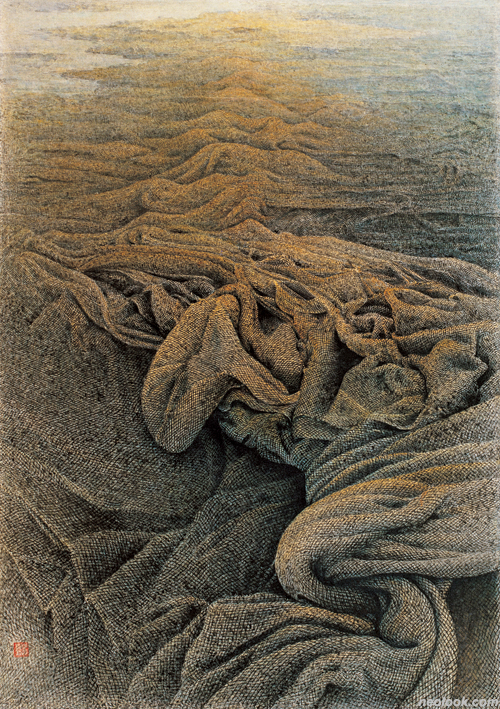
- 이상원_해변 Beach_한지에 먹, 유채_145×100cm_1982

- 이상원_마대의 얼굴 The Face of Gunny Bag_한지에 먹, 유채_106×153cm_1988
마대의 얼굴 · 막 · 해변의 풍경 ● 이상원 화백의 초기작에 속하는 일련의 연작은 쇠락한 대상을 그렸습니다. 작품은 복잡한 세부가 화면을 가득채운 대작입니다. 극사실회화라고 칭해지는 초기작은 서구의 포토리얼리즘, 하이퍼리얼리즘 등이 1970~80년도에 한국의 화단에서 붐을 이루고 있을 때와 시기적으로 일치합니다. 그러나 이상원 화백의 회화는 객관적이고 냉정한 시점으로 바라본 세계가 아니라는 점에서 차이가 분명합니다. 이 작품들의 참의미는 땀 흘리며 하루하루를 살아가는 민중들의 빛바래고 오래된 작업복과 같은 색조를 지닌다는 것에 있습니다. 곧 사라지게 될 대상들이 뿜어내는 존재감. 주목받지 못하는 대상임에도 그 안에 예술적 아름다움을 찾아내게 되는 연금술적인 신비감에 있습니다.
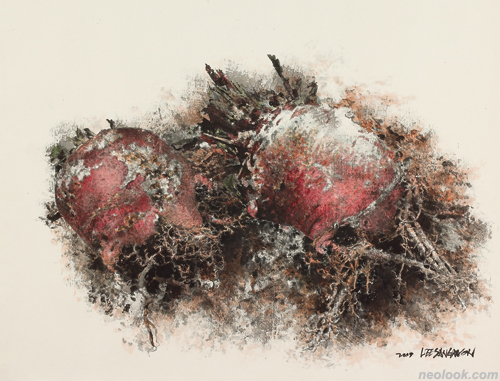
- 이상원_대자연 Mother Nature_한지에 먹, 유채_126×165cm_2009
대자연 ● 이상원 화백은 자신의 노년에 이르러 더욱 사소하며 작은 것들에 시선을 주었습니다. 호박과 순무 속에서 자연을 바라보고 생명력을 느끼며 전에 없던 원색에 가까운 색상을 가미하여 그려내었습니다. 수묵의 필치도 파묵법을 이용하여 오히려 어눌하고 단순한 느낌의 회화로 나아가고 있습니다. 재료의 특징 ● 작품은 한지 위에 먹과 유화물감으로 제작되었습니다. 한지에 수성안료와 유성안료를 결합하는 기법은 독창적입니다. 기법에 있어서 동서양의 결합은 작품 세계의 내용과도 연결됩니다. 한지와 여백으로 표현되는 동양성에는 인간은 만물의 일부분이라는 동양 철학이 내재되어 있습니다. 집요하게 사물의 세부를 표현하는 유화물감의 사용은 사실성에 근거하고자 하는 실증주의자의 자세를 엿볼 수 있는 부분입니다. 재료의 사용은 정신의 표현이 되고 내용과 형식이 통합되어 한국 회화의 정체성을 드러낸다고 볼 수 있습니다. ■ 이상원 미술관
Nestling under the Hwa-ak Mountain in Chuncheon-si, Gangwon-do, LEESANGWON MUSEUM OF ART opens to public view with more than two thousand pieces of painter Lee Sangwon, the fruition of his forty years of career in art, as the museum's collection. "For Things Abandoned" is its inaugural exhibition in celebration of the opening of the museum. A trove of sixty pieces of Lee Sangwon paintings is unfolded on the show in order to invite the public to discover his world of art works in the museum representing him. The Time and Space ● A series of works "The Time and Space" placed Lee Sangwon onto the spotlight of Korean artistic community. The early versions of the series (late 1970s) depict the ruts imprinted in the mud and rice paddies and fields after the harvest, followed by the wheel marks in the snow since the 1990s. While the early marks are rendered in the deep wounds left by the civilization of the land, the later "The Time and Space" editions are refined into formative artworks, allowing abstract and metaphorical interpretation. The point that the only element suggestive of modern civilization in all his works is the mark evokes various interpretations. The East Sea People; The Portrait of Eternity ● In the 1990s, painter Lee Sangwon started out portraits by a "The East Sea People" series on the fishing village people by the East Sea, and then the people living in Varanasi, India in the 2000s. He found the epitome of the humans in the realities of suffering in life, which is striking accord with his compassion for things abandoned lying on the basis of his art world. The figures presented side by side with the deserted things fallen out of use are particularly shocking so as to send shivers down the spine since they imply the moment that the human position as a master of civilization is reversed. On the other hand, they also express the preciousness of life by illustrating the aspect of the humans stepping closer to extinction with serenity. The Face of Gunny Bag; The Membrane; The Landscape of Beach ● These series of Lee Sangwon's early works feature the subjects in the decline. They are his masterpieces full of complex details entirely. The early pieces regarded as hyper realism paintings coincide with a time when Korean art circle was on trend with the Western realism and hyper realism in the 1970s and '80s. However, a clear distinction between the two is explained by the fact that his works are not from an objective and cynical point of view. His works do meaningfully take on the same tone as that of old faded working uniforms of people living day by day sweating at work. There is the sense of presence radiated from the objects that will soon be lost and an alchemistic art of mystery of finding the beauty in things that do not receive any more attention. Mother Nature ● In his later years, painter Lee Sangwon gravitated to the little trivial things. The pumpkin and turnip are captured as his way of seeing and understanding nature and appreciating the power of life in them. Unprecedented nearly primary colors are added into his palette to make them new highlights. His Indian ink paintings are rather rendered in a simpler and less articulated manner by means of Pamuk method, a stroke of the brush to create an effect of a three-dimensional sense by breaking lines. Materials ● Indian ink and oil paint on Korean paper constitute the mediums for painter Lee Sangwon. His technique of blending oil and water-based pigments is a novelty. The combination of Western and Eastern techniques is in line with the concept of his art world. Eastern attitudes represented by the medium of Korean paper and the space between the object and the margin embody Eastern philosophy that the human is an inherent part of all things. The use of oil paint to express the details of the objects persistently hints at the aspect of positivists set grounded on the facts. The material used in a work defines what is the spirit of it. The idea and format converge to reveal the identity of Korean paintings. ■ LEESANGWON MUSEUM
Vol.20141018a | 이상원展 / LEESANGWON / 李相元 / painting

